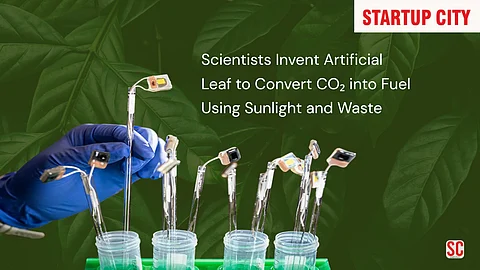

Climate change, rising pollution levels, and dependence on fossil fuels remain among the most urgent challenges facing humanity today. But a breakthrough technology inspired by nature might be on the horizon to help address these issues—scientists have engineered an artificial leaf that harnesses sunlight and industrial waste to convert carbon dioxide (CO₂) into usable fuel.
The concept of an “artificial leaf” might evoke images of plastic foliage, but this innovation is a sophisticated chemical system designed to replicate the natural process of photosynthesis. Much like a real leaf uses chlorophyll to capture sunlight, the artificial leaf employs a material called perovskite, renowned for its exceptional ability to absorb solar energy efficiently.
Paired with perovskite is a specially engineered catalytic surface covered with microscopic copper nanoflowers. These nanostructures act as catalysts that facilitate the chemical transformation of captured CO₂ into hydrocarbons such as ethane (a natural gas component) and ethylene (used widely in manufacturing plastics, antifreeze, and more). This not only traps harmful carbon emissions but also transforms them into valuable fuels and industrial feedstocks.
Earlier attempts at artificial photosynthesis faced a major obstacle—the need to split water to obtain hydrogen, an energy-intensive step limiting practicality. The new artificial leaf technology circumvents this by replacing water with glycerol, an industrial byproduct primarily discarded from biodiesel production.
This switch offers a remarkable efficiency boost—up to 200 times greater than previous models—while also recycling an abundant waste material. By combining waste reduction with cleaner fuel production, this innovation embodies a win-win approach to sustainability.
The artificial leaf doesn’t just produce fuels. It also generates valuable chemical compounds such as glycerate, lactate, and formate—which have applications in pharmaceuticals and cosmetics industries. This broadens the technology’s impact beyond energy, opening pathways for cleaner, sustainable chemical manufacturing.
Despite the promising breakthrough, challenges remain. Currently, the artificial leaf converts only about 10% of the CO₂ it processes into target hydrocarbons, with the rest forming other byproducts. Scientists are actively working on redesigning the copper nanoflowers to improve the selectivity and overall efficiency.
Scaling this lab prototype to industrial levels will require substantial investment, advanced materials engineering, and rigorous testing. Economic feasibility and integration into existing infrastructure will also influence adoption rates.
The vision is compelling: factories, power plants, and even aircraft maintenance hubs could one day be equipped with artificial leaves, capturing their CO₂ emissions and converting them on-site into fuel and valuable chemicals—all powered by sunlight.
While this remains an emerging technology, it signals a transformative shift toward circular energy systems that recycle carbon emissions rather than adding to the atmosphere. With continued innovation and support, artificial leaves may become a cornerstone in the global fight against climate change.